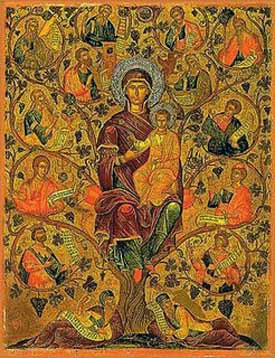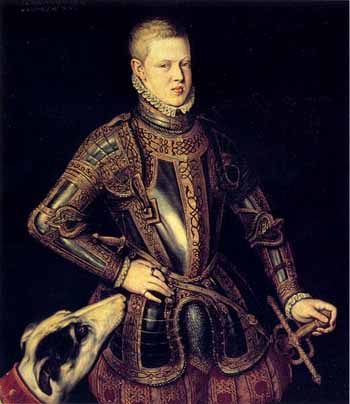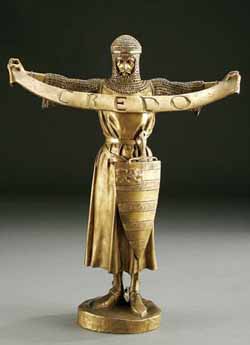 |
History: Personalities
Dom Sebastian, the Star of Portugal
Plinio Corrêa de Oliveira
I don't know if this has ever happened to you, but more than once I have looked at the trunk and branches of a plant, and then have asked myself," How can this plant give the flower that it does? How can its rough bark generate such marvelous beauty? For example, the trunk of a rose plant is common, without anything particularly beautiful about it. But it hides a mystery: It has the capacity to generate a great quantity of flowers, each one different from the other.
I believe that the lives of the peoples and families are like plants. At first appearance, they look common, but as they fulfill their vocations they generate beautiful flowers. They generate persons who bring the vocation of that people or family to its apex so that those who see a lady of this distinction exclaim in admiration. "Oh! What a marvelous flower!" Or if it is a man, they say, "Oh! What a brilliant star!"

From the Jesse root a flower bloomed... |
When a nation looks at one of these exquisite persons it generates, as if it were a plant, it says: "From my roots deep in the ground, a flower for mankind and a star for the heavens was born." From a certain point of view, this constitutes the nucleus of the history of a people or a family.
Sometimes the archetypes of a family are preceded by other members who have some of the characteristics of that final beauty that will appear further on in one member in an exceptional way. Many times in the histories of the Saints or the great personages of a country, one can trace the gradual formation of that perfect archetype that came later.
We know that all the Patriarchs and Prophets of the Old Testament longed for the Messiah. Some of them, such as Solomon and Isaiah, had glimpsed His birth by means of Our Lady, the root of Jesse that would bloom and engender the Messiah. According to one seer - I believe it was Anne Catherine Emmerick - Our Lady used to meditate on the coming of the Messiah and imagine how He would be. Doing this she gradually generated in her mind His most holy and perfect Face. At the moment when she finished that work of conceiving in her mind the ensemble of His moral physiognomy, the Angel Gabriel appeared to her and invited her to be the Mother of the Word Incarnate. Thus, after a long mental gestation of a whole people, after the longings of all the Prophets and after that contemplation of Our Lady, the One awaited by the nations came.
Here we have a rule that applies to everything living. When a people or a family progresses as it should, then at a certain moment one will appear who is superior, a supreme archetype who fulfills the vocation of that nation or family in a way no one could imagine.
The archetype of Portugal
This rule applies to the history of Portugal past, present and future. In the history of Portugal I include the history of Brazil because, despite the political separation of these two countries, Portugal and Brazil never stopping sharing the same soul and they represent before the eyes of God only one reality.
Dom Sebastian can be called the flower, the star, the one awaited by Portugal. His grandfather was Emperor Charles V, of whom it was said the sun never sets on his dominions. Charlemagne and Charles V were the highest representations of the imperial power and dignity in the whole West.

Dom Sebastian at age 17 |
If you look at a picture of Dom Sebastian, you will see a physiognomy that shows sovereignty and decision; no one exercises power over him. He is the lord upon whom no one imposes laws; he resolves things as he sees fit. He is a Portuguese Prince, but his bearing and demeanor also reveal a Prince of the House of Austria. The same House of Austria that extended its territories in the East beyond the Balkans to the very borders of Russia, in the West it extended to Portugal and its shores of the Atlantic. The grandeur of the Habsburgs is also represented in this picture as one of its principal expressions.
Dom Sebastian was a delicate man; notwithstanding he was a great warrior. He was a man who fought against the Revolution of the Renaissance. The Renaissance was characterized by a proud pagan mentality turned toward the pleasures of this earth. The Renaissance also reached wrong conclusions regarding Kings, pretending that Monarchs should be humanistic models who promote artistic values, rather than be vassals of God turned toward the expansion of the Catholic Faith. Dom Sebastian fought that bad tendency. For him the final end of a King was to serve and help spread the Faith. This is why he wanted to go to Africa.
In 1557, the year his reign began, he was also the King of Brazil, which had been discovered in 1500. When the caravels of Pedro Álvares Cabral landed in Brazil - at the time of King Manuel I - they brought missionaries to expand the Faith. The main goal, however, was to find gold and expand the King's temporal power in the competition of conquest with the other European monarchs. The Portuguese and Spanish era of discovery initiated the concept of the mercantile society, a bourgeois-dominated society. In that society the spirit of chivalry was quickly dying. The desire for riches became the major propulsion of the navigations.
Dom Sebastian was a clearly anti-Renaissance King. His main goal was truly to make Our Lord Jesus Christ the King of this world. There is no doubt that he also desired the grandeur of Portugal, but without the Kingship of Christ, for him the grandeur of Portugal diminished significantly.
The Pope issued a Bull that gave the status of Crusade to the expedition to Africa. At that time, two Monarchs offered Dom Sebastian Princesses of their houses for spouses: Philip II of Spain and Queen Catherine of Medicis of France. He sent them each a message affirming he would marry the Princess whose sovereign would support his expedition to Africa. Since the answers he received were ambiguous, he chose neither one. He certainly would marry upon his return, but in fact he never did. He went to Africa in 1578 at age 24 and died fighting the Moors in Morocco at the Battle of Alcácer Quibir. He entered the annals of History as the virgin King; he went to eternity bringing the pure incense of virginity to burn before God forever.

Dom Sebastian wanted to restore a chivalry at the service of the Faith |
He loved the Catholic Faith above all things. Realizing that the Huguenots were on the brink of taking the French Crown, he sent King Charles IX of France a large quantity of gold with this message: Do whatever you deem appropriate with this gold as long as it is used to vanquish the Huguenots. He did not ask for any advantage for Portugal or for himself. This is an Apostle King, who understood that gold is not an end in itself, but a means to serve the Church and fight for the expansion of Christ's Kingship.
The Portuguese people realized the supreme elevation and transcendence of their young King, a Monarch on the level of St. Louis of France and St. Ferdinand of Castile. In a certain way, they understood that he was the fulfillment of his forefathers: Dom Afonso Henriques, who founded Portugal, who received the apparition of Christ on the fields of Ourique, and the generations of Kings who came after him. They understood that all those Kings flourished in Dom Sebastian. The people of Portugal had the grandeur of soul to recognize that he was the King of their highest dreams. He was superior to what they could have imagined; he was the son of the blessing, the favorite of Our Lady, the son sent by God. And the people loved him with a love that participated in their love for God.
Portugal not only felt itself to be the son of this King, but also in a certain way his father, because he became orphan very early - his father died two weeks before his birth and he succeeded to the throne at age three, on the death of his grandfather King John III. Thus, from the time he was an infant Portugal had reared him and looked out for him. When he was a child, any small mishap that befell him caused concern in Portugal. When he became a youth, everything he did was a source of hope for Portugal.
When he resolved to embark on the Crusade to Africa, his people rejoiced, hoping that the great days of Portuguese History would return. The strongboxes of the royal treasury filled with money; the fields filled with knights. As Portugal prepared for the King's Crusade to Africa, a completely anti-Renaissance spirit flourished everywhere.
Continued

Translated from the transcript of the tape
and summarized by A.S. Guimarães
Posted May 22, 2011

Related Topics of Interest
 Dom Sebastian's Legacy Dom Sebastian's Legacy
 The Miracle of Ourique & the Birth of Portugal The Miracle of Ourique & the Birth of Portugal
 Different Types of Nobility Different Types of Nobility
 Blessed Nuno Alvares Pereira, Hero of Portugal Blessed Nuno Alvares Pereira, Hero of Portugal
 The Strength, Glory & Fecundity of Chastity The Strength, Glory & Fecundity of Chastity
 Revolution & Counter-Revolution in the Tendencies, Ideas & Facts Revolution & Counter-Revolution in the Tendencies, Ideas & Facts
 Clans and Human Types Clans and Human Types

Related Works of Interest
  

|
History | Home | Books | CDs | Search | Contact Us | Donate

© 2002-
Tradition in Action, Inc. All Rights Reserved
|
 |
|